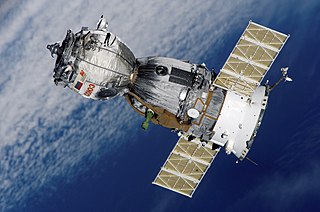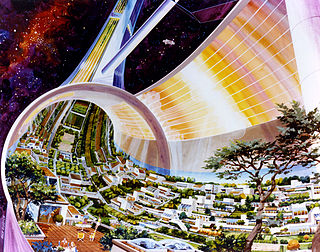Related Research Articles

Human spaceflight is spaceflight with a crew or passengers aboard a spacecraft, often with the spacecraft being operated directly by the onboard human crew. Spacecraft can also be remotely operated from ground stations on Earth, or autonomously, without any direct human involvement. People trained for spaceflight are called astronauts, cosmonauts (Russian), or taikonauts (Chinese); and non-professionals are referred to as spaceflight participants or spacefarers.

Space exploration is the use of astronomy and space technology to explore outer space. While the exploration of space is currently carried out mainly by astronomers with telescopes, its physical exploration is conducted both by uncrewed robotic space probes and human spaceflight. Space exploration, like its classical form astronomy, is one of the main sources for space science.

A spacecraft is a vehicle that is designed to fly and operate in outer space. Spacecraft are used for a variety of purposes, including communications, Earth observation, meteorology, navigation, space colonization, planetary exploration, and transportation of humans and cargo. All spacecraft except single-stage-to-orbit vehicles cannot get into space on their own, and require a launch vehicle.

A space station is a spacecraft which remains in orbit and hosts humans for extended periods of time. It therefore is an artificial satellite featuring habitation facilities. The purpose of maintaining a space station varies depending on the program. Most often space stations have been research stations, but they have also served military or commercial uses, such as hosting space tourists.

A space settlement is a settlement in outer space, sustaining more extensively habitation facilities in space than a general space station or spacecraft. Possibly including closed ecological systems, its particular purpose is permanent habitation.

A gravity assist, gravity assist maneuver, swing-by, or generally a gravitational slingshot in orbital mechanics, is a type of spaceflight flyby which makes use of the relative movement and gravity of a planet or other astronomical object to alter the path and speed of a spacecraft, typically to save propellant and reduce expense.
Bigelow Aerospace was an American space design and manufacturing company which closed its doors in 2020. It was an aeronautics and outer space technology company which manufactured and developed expandable space station modules. Bigelow Aerospace was founded by Robert Bigelow in 1998, and was based in North Las Vegas, Nevada. It was funded in large part by the profit Bigelow gained through his ownership of the hotel chain, Budget Suites of America.

The process of assembling the International Space Station (ISS) has been under way since the 1990s. Zarya, the first ISS module, was launched by a Proton rocket on 20 November 1998. The STS-88 Space Shuttle mission followed two weeks after Zarya was launched, bringing Unity, the first of three node modules, and connecting it to Zarya. This bare 2-module core of the ISS remained uncrewed for the next one and a half years, until in July 2000 the Russian module Zvezda was launched by a Proton rocket, allowing a maximum crew of three astronauts or cosmonauts to be on the ISS permanently.

A rotating wheel space station, also known as a von Braun wheel, is a concept for a hypothetical wheel-shaped space station. Originally proposed by Konstantin Tsiolkovsky in 1903, the idea was expanded by Herman Potočnik in 1929, and popularized by Wernher von Braun in 1952.

The National Aeronautics and Space Administration is an independent agency of the US federal government responsible for the United States' civil space program, aeronautics research and space research. Established in 1958, it succeeded the National Advisory Committee for Aeronautics (NACA) to give the US space development effort a distinct civilian orientation, emphasizing peaceful applications in space science. It has since led most of America's space exploration programs, including Project Mercury, Project Gemini, the 1968–1972 Apollo Moon landing missions, the Skylab space station, and the Space Shuttle. Currently, NASA supports the International Space Station (ISS) along with the Commercial Crew Program, and oversees the development of the Orion spacecraft and the Space Launch System for the lunar Artemis program.

Starship HLS is a lunar lander variant of the Starship spacecraft that is slated to transfer astronauts from a lunar orbit to the surface of the Moon and back. It is being designed and built by SpaceX under the Human Landing System contract to NASA as a critical element of NASA's Artemis program to land a crew on the Moon.
Gateway Spaceport was formed in 2012 to build the first rotating spaceport and space hotel. On January 1, 2022, Gateway Foundation's name was changed to Gateway Spaceport LLC.
Shensuo, formerly Interstellar Express, is a proposed Chinese National Space Administration program designed to explore the heliosphere and interstellar space. The program will feature two or three space probes that were initially planned to be launched in 2024 and follow differing trajectories to encounter Jupiter to assist them out of the Solar System. The first probe, IHP-1, will travel toward the nose of the heliosphere, while the second probe, IHP-2, will fly near to the tail, skimming by Neptune and Triton in January 2038. There may be another probe—tentatively IHP-3—which would launch in 2030 to explore to the northern half of the heliosphere. IHP-1 and IHP-2 would be the sixth and seventh spacecraft to leave the Solar System, as well as first non-NASA probes to achieve this status.
Starlab is a LEO commercial space station currently under development by Starlab Space, a joint venture between the U.S. company Voyager Space and European company Airbus. If development continues beyond the initially-funded phase in 2021–24, then Starlab would be launched before the decommissioning of the ISS, no earlier than 2028. The development program has received partial funding from both NASA and the ESA.
Vast is a privately-held American aerospace company headquartered in Long Beach, California. It was founded in 2021 by entrepreneur Jed McCaleb with the goal of developing artificial gravity space stations to "expand humanity beyond the solar system".

Vast-1 is a planned private spaceflight to the Haven-1 space station, planned to launch no earlier than August 2025 by American aerospace company Vast. Vast-1 is expected to launch on a Falcon 9 rocket, using a Crew Dragon vehicle, both manufactured by SpaceX. The stay on the station is planned to last no more than 30 days. The spaceflight will include four astronauts who will be trained by SpaceX on their Crew Dragon capsule through simulations and formations.
References
- ↑ "About Above Space". Above Space.
- ↑ Street, Francesca (2 May 2022). "Inside the space hotel scheduled to open in 2025". CNN. Archived from the original on 17 October 2024. Retrieved 18 October 2024.
- 1 2 3 Compton, Natalie B. (3 March 2021). "A vacation that's out of this world: The first space hotel is set to start construction by 2026". The Washington Post . Retrieved 4 March 2021.
- ↑ Bergan, Brad (30 January 2021). "Company of NASA Stars Building Orbital Space Hotel With Artificial Gravity". Interesting Engineering. Retrieved 4 March 2021.
- ↑ Mackenzie, A. J. "The enduring fantasy of space hotels". The Space Review. Retrieved 20 July 2021.
- ↑ "Pioneer Station". abovespace.com.
- ↑ Francesca Street (2 May 2022). "Inside the space hotel scheduled to open in 2025". CNN. Retrieved 2022-05-13.
